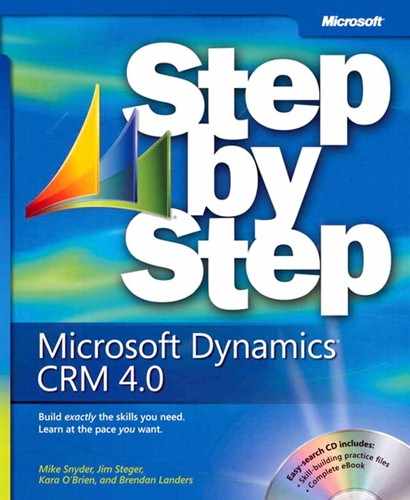Chapter at a Glance
✓ | Create duplicate detection rules. |
✓ | Use the Duplicate Detection Wizard. |
✓ | View the results of a duplicate detection job. |
✓ | Resolve duplicate records. |
✓ | Create advanced duplicate detection rules. |
Data quality is a key factor in the success of your Microsoft Dynamics CRM application. A pristine database leads to accurate reporting and higher user adoption. A large threat to data consistency is duplicate records. Although it is easy to enter a duplicate record in CRM applications, Microsoft Dynamics CRM provides you with a great tool that lets you detect duplicates before and after they are entered. Common examples of duplicate records are:
A company entered under both its legal name and an acronym (for example, Affordable Sports Equipment and ASE).
A contact entered under the individual’s full name and a nickname (for example, Michael Alexander and Mike Alexander).
In this chapter, you will learn how to create duplicate detection rules to keep your Microsoft Dynamics CRM database free of duplicates. You will also learn how to detect duplicate records and react appropriately by using delete, deactivate, or merge functionality.
Troubleshooting
Graphics and operating system–related instructions in this book reflect the Windows Vista user interface. If your computer is running Windows XP and you experience trouble following the instructions as written, refer to the "Information for Readers Running Windows XP" section at the beginning of this book.
Important
The images used in this book reflect the default form and field names in Microsoft Dynamics CRM. Because the software offers extensive customization capabilities, it’s possible that some of the record types or fields have been relabeled in your Microsoft Dynamics CRM environment. If you cannot find the forms, fields, or security roles referenced in this chapter, contact your system administrator for assistance.
Important
You must know the location of your Microsoft Dynamics CRM Web site to work the exercises in this book. Check with your system administrator to verify the Web address if you don’t know it.
Many organizations define duplicate records uniquely. Some have simple rules that include a single field match (for example, e-mail address), and others determine duplicates based on multiple field matching criteria using both partial and complete text. Consider the following scenarios, along with their related pros and cons.
Duplicate detection rule | Pros | Cons |
|---|---|---|
Detect contact records with the same e-mail address. | If you are working with contacts at companies, each person typically has a unique e-mail address | If you are working with contacts unrelated to a company, contacts might be using a shared email address (for example, [email protected]). |
Detect account records with the same street address, city, and state | Most street addresses will belong to just one company, especially if you are diligently capturing suite numbers. | If you are working with companies in metropolitan areas, it is common to have many companies at one street address. (For example, more than 100 companies work in the Sears Tower in Chicago.) |
Microsoft Dynamics CRM empowers you to determine the logic that is right for your needs and allows you to implement that logic by using a simple wizard. System administrators can specify when duplicate detection rules run. For example, duplicate detection rules can be set to run at the following times:
When a record is created or updated
When Microsoft Dynamics CRM for Outlook goes from offline to online
During data import
In this exercise, you will create duplicate detection rules.
Note
USE your own Microsoft Dynamics CRM installation in place of the Adventure Works Cycle site shown in this exercise.
BE SURE TO use the Windows Internet Explorer Web browser to navigate to your Microsoft Dynamics CRM Web site before beginning this exercise.
In the Settings area, click Data Management, and then select Duplicate Detection Rules.
Some duplicate detection rules might be already listed. Microsoft Dynamics CRM includes three default rules:
Accounts with the same e-mail address
Contacts with the same e-mail address
Leads with the same e-mail address
These rules are self-explanatory; any two account, contact, or lead records with the same e-mail address will be considered duplicates when these rules are run.
In the grid toolbar, click the New button.
The New Duplicate Detection Rule form opens.
Complete the New Duplicate Detection Rule form by using the following values:
Name
Contacts with the same name
Description
Detect Contacts that have an exact name match.
Base Record Type
Contact
Attribute
Full Name
Criteria
Exact Match
In the form toolbar, click the Save and Close button.
Select the newly created duplicate detection rule, and click Publish.
You have successfully created a duplicate detection rule. Now, when a duplicate detection job is run against contacts, this rule will run along with any other rules that exist.





